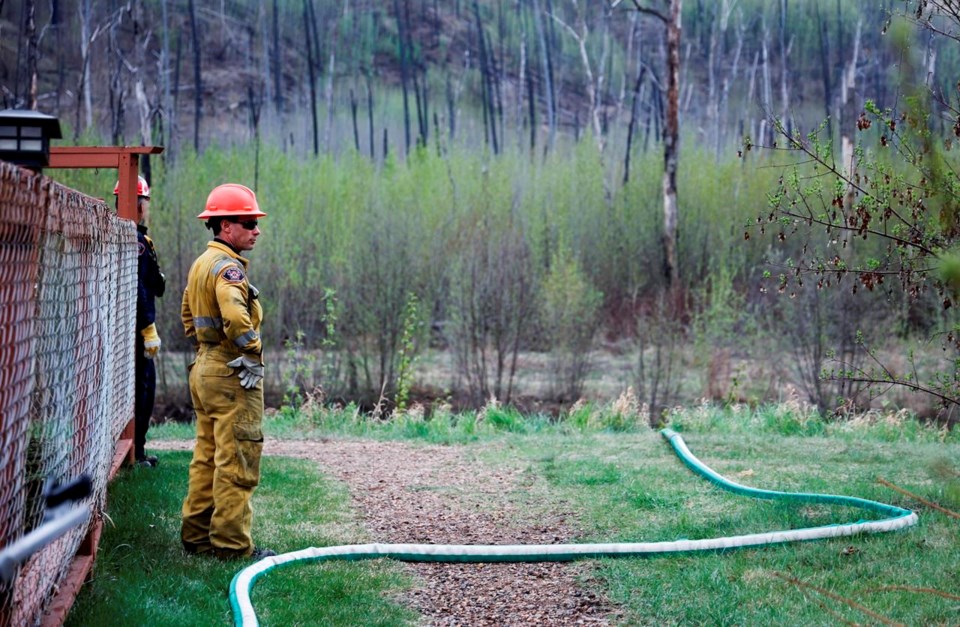FORT MCMURRAY, Alta. — Every day since a wildfire began menacing the city of Fort McMurray, Alta., grimy, exhausted firefighters have been spilling out of helicopters at the end of another one of the toughest shifts around.
Hard, manual labour?
"Yes," said Gavin Hojka, incident commander in charge of 172 wildland firefighters. "Very."
There is no road access to the front lines of the fire, which has not grown thanks to cool, damp weather and the hard work of the crews.
Teams of between eight and 20 are dropped off by helicopters early each morning. They make their way on foot to the flames, carrying pumps, chainsaws, shovels, axes and hoses — lots and lots of hoses.
"They'll be bringing a dozen boxes of hose for the day," Hojka said.
"Every single day we're bringing out more hose. There are thousands and thousands of feet of hose."
Each box of hose weighs about 27 kilograms. The pumps that fill them weigh about 30 kilograms, carried on someone's back to the nearest beaver pond, stream or river.
With water and hand tools they attack the fire for between 12 and 14 hours at a stretch, fuelled only by the bag lunch in their packs. Then the helicopter comes to pick them up for a little rest before they're back at it.
"We do everything we can to bring them home at night," said Hojka. "We make sure we have someone flying around in a helicopter being an eye in the sky, a lookout."
Still, the fire remained out of control Friday and about 6,600 residents in four neighbourhoods of the oilsands hub remained out of their homes.
It's one of several fires that have forced the evacuation of communities in Western Canada.
Fort Nelson, B.C., a town of 4,700, was evacuated a week ago. Recent videos posted on social media show what appear to be multiple homes destroyed outside the community.
B.C.’s Emergency Management Minister Bowinn Ma said the province's worst fears about those fires hadn't materialized but the region wasn't yet "out of the woods."
In northwest Manitoba, there was good news for 675 residents forced out last weekend from in and around Cranberry Portage.
The provincial wildfire service said that fire was under control and the weather was co-operating, so residents would be allowed to return Sunday. It said a small number of properties were damaged.
Back in Fort McMurray, some of the four neighbourhoods evacuated Tuesday appeared deserted, with garbage cans lined up neatly on driveways beside cars, trucks and all-terrain vehicles. Police, emergency workers and birds were the only ones around.
In Grayling Terrace, crews set up sprinklers capable of spraying 600 litres of water a minute on trees and bush near the homes.
In Beacon Hill, young poplars near homes were sprayed a deep shade of orange from fire retardant, a portion of the 168,000 litres of the phosphate-based chemical that's been sprayed around the city.
The rest of the city of 68,000 was told they are on evacuation alert and may have to leave on short notice.
The fire remained about 200 square kilometres in size and just under six kilometres from the city's southern outskirts. About 10 millimetres of rain fell in the area Thursday night, and more was in the forecast for the long weekend.
Despite the favourable weather, evacuees weren't expected to be allowed back until at least Tuesday.
Jody Butz, the fire chief for the Regional Municipality of Wood Buffalo, said officials were developing a plan to welcome back evacuees when it's safe.
Residents in other neighbourhoods not under the evacuation order who voluntarily left are allowed back any time, said Mayor Sandy Bowman.
"People are going to work, businesses are open, traffic is flowing," he said.
He said officials learned a valuable lesson when a massive fire eight years ago started burning parts of Fort McMurray as everyone was fleeing for safety. That fire torched more than 2,400 homes.
"The important lesson in 2016 is that we shouldn't be fighting a fire and evacuating neighbourhoods at the same time," said Bowman.
"We are better prepared this time, and we're better positioned to protect your community. As soon as we can welcome you home, we will do so."
This report by The Canadian Press was first published May 17, 2024.
Bob Weber, The Canadian Press



